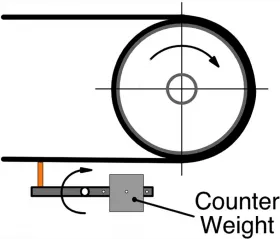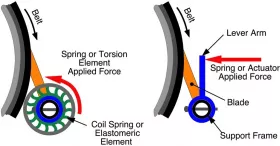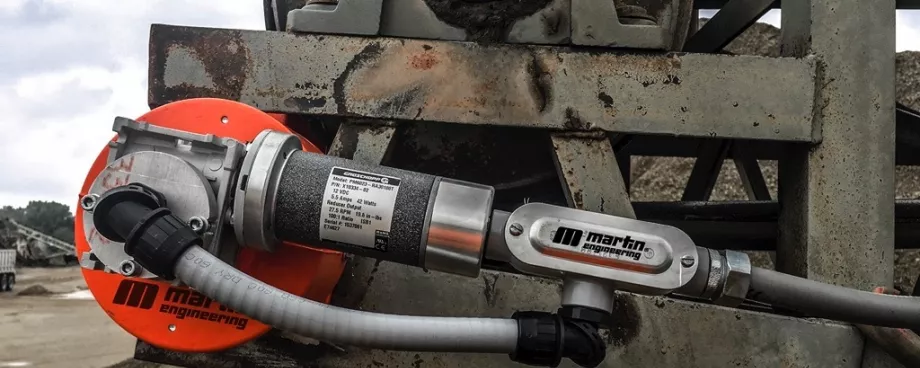Rotary Tensioners
Rotary tensioners utilizing an actuator are principally designed using a lever arm or an elastomeric element that is concentric with the belt cleaner support shaft. They apply a blade-to-belt contact surface determined by the actuating force and linkage geometry. The energy source delivers a force to the lever arm which rotates the shaft and forces the belt cleaner blade(s) against the belt surface. Rotary designs tend to be compact and, in most cases, the actuator(s) can be mounted at any orientation, which provides options for installing the belt cleaner in the optimum position.
Counterweight Tensioner
At one time the most common rotary tensioner was a counterweighted lever arm, with its position adjusted to apply the design cleaning force to a blade or blades that contact the belt. A counterweight can be mounted on one end of the shaft or both. Usually, the initial installation would have the arm angle set so that at the midpoint of the blade wear the arm would be horizontal, thus roughly averaging the design cleaning force over the life of the blade. [Fig.4]

The primary advantage of the counterweight design is that it is self-adjusting by gravity.
The disadvantages of the counterweight design are:
- the lack of damping which allows the blade and therefore the weight to bounce when struck by a splice, strongly adhered material, like ice or a defect in the belt. The unexpected movement of the counterweight can represent a safety hazard and uncontrolled bouncing can result in belt top cover damage;
- the counterweight tensioner takes a significant amount of space and;
- if the counterweight arm cannot be mounted horizontally there is a reduction in the force applied to the blade, because the effective lever arm is shortened.
Rotary Lever Arm and Actuator Tensioners
Rotary adjustment of the belt cleaning blade can be accomplished in several ways. The support frame is almost always in a fixed location but free to rotate. The required tensioning forces can be applied by many types of actuators, such as: springs, fluid cylinders, electric actuators or from torque stored in an elastomeric element. Rotary tensioners are often used with elastomeric blades, where the change in blade height and thickness as it wears is significant. [Fig.5]

The advantages of rotary tensioners are:
- a compact design;
- a single tensioner mounted on one side of the conveyor can often be used for a range of blade styles and belt widths;
- they can be designed to minimize the number of times the tensioner has to be adjusted during the life of the blade and;
- many types of actuators can be used.
The disadvantages of rotary tensioners are:
- there can be a safety hazard if the support frame is mounted too far from the pulley and the cleaner pulls through;
- the mounting location of the axis of rotation is critical for proper blade cleaning angle;
- the constant force output by some actuators can result in a wide variance in cleaning pressure and blade life over time;
- when a tensioner is required on both ends of the support frame, it is often difficult to access the drive side of the conveyor for mounting and adjustment.




















